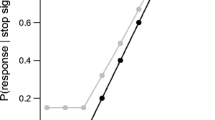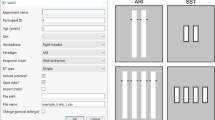Abstract
The effect of response readiness on the stop-signal reaction time (SSRT) in a stop-signal task was examined, with the stop-signal delay updated following a staircase procedure. We computed SSRT on the basis of a horse race model. A fore-period effect was computed, which described subjects’ readiness to respond to the GO signal. The results showed that the fore-period effect correlated positively with SSRT, providing evidence of the effect of response prepotency on stop signal processing. This finding suggests that response readiness needs to be accounted for in examining response inhibition in a stop-signal task.



Similar content being viewed by others
References
Armstrong IT, Munoz DP (2003) Inhibitory control of eye movements during oculomotor countermanding in adults with attention-deficit hyperactivity disorder. Exp Brain Res 152:444–452
Aaron AR, Fletcher PC, Bullmore ET, Sahakian BJ, Robbins TW (2003) Stop-signal inhibition disrupted by damage to right inferior frontal gyrus in humans. Nature Neurosci 6:115–116
Badcock JC, Michie PT, Johnson L, Combrinck J (2002) Acts of control in schizophrenia: dissociating the components of inhibition. Psychol Med 32:287–297
Bertelson P, Tisseyre F (1968) The time-course of preparation with regular and irregular foreperiods. Q J Exp Psychol 20:297–300
Colonius H, Özyurt J, Arndt PA (2001) Countermanding saccades with auditory stop signals: Testing the race model. Vision Res 41:1951–1968
Dimitrov M, Nakic M, Elpern-Waxman J, Granetz J, O’Grady J, Phipps M, Milne E, Logan GD, Hasher L, Grafman J (2003) Inhibitory attentional control in patients with frontal lobe damage. Brain Cognit 52:258–270
Dimoska A, Johnstone SJ, Barry RJ, Clarke AR (2003) Inhibitory motor control in children with attention-deficit/hyperactivity disorder: event-related potentials in the stop-signal paradigm. Biol Psychiatr 54:1345–1354
Fillmore MT, Rush CR (2002) Impaired inhibitory control of behavior in chronic cocaine users. Drug Alcohol Depend 66:265–273
Gauggel S, Rieger M, Feghoff TA (2004) Inhibition of ongoing responses in patients with Parkinson’s disease. J Neurol Neurosurg Psychiatr 75:539–44
Levitt H (1970) Transformed up-down methods in psychoacoustics. J Acoust Soc Am 49:467–477
Logan GD (1994) On the ability to inhibit thought and action: a user’s guide to stop signal paradigm.In: Dagenbach D, Carr TH (eds) Inhibitory processes in attention, memory and language. Academic, San Diego, pp 189–239
Logan GD, Cowan WB (1984) On the ability to inhibit thought and action: a theory of an act of control. Psychol Rev 91:295–327
Moeller FG, Barratt ES, Dougherty DM, Schmitz JM, Swann AC (2001) Psychiatric aspects of impulsivity. Am J Psychiatr 158:1783–1793
Oosterlaan J, Sergeant JA (1996) Inhibition in ADHD, aggressive, and anxious children: a biologically based model of child psychopathology. J Abnorm Child Psychol 24:19–36
Overtoom CC, Kenemans JL, Verbaten MN, Kemner C, van der Molen MW, van Engeland H, Buitelaar JK, Koelega HS (2002) Inhibition in children with attention-deficit/hyperactivity disorder: a psychophysiological study of the stop task. Biol Psychiatr 51:668–676
Özyurt J, Colonius H, Arndt PA (2003) Countermanding saccades: evidence against independent processing of go and stop signals. Percept Psychophys 65:420–428
Rieger M, Gauggel S, Burmeister K (2003) Inhibition of ongoing responses following frontal, nonfrontal, and basal ganglia lesions. Neuropsychol 17:272–282
Rolls ET, Hornak J, Wade D, McGrath J (1994) Emotion-related learning in patients with social and emotional changes associated with frontal lobe damage. J Neurol Neurosurg Psychiatr 57:1518–1524
Rubia K, Oosterlaan J, Sergeant JA, Brandeis D, von Leeuwen T (1998) Inhibitory dysfunction in hyperactive boys. Behav Brain Res 94:25–32
Schachar R, Mota VL, Logan GD, Tannoc R, Klim P. (1995) Deficient inhibitory control in attention deficit hyperactivity disorder. J Abnorm Child Psychol 23:411–437
Stewart JA, Tannock R (1999) Inhibitory control differences following mild head injury. Brain Cognit 41:411–416
van den Wildenberg WPM, van der Molen MW, Logan GD (2002) Reduced response readiness delays stop signal inhibition. Acta Psychol 111:155–169
Williams BR, Ponesse JS, Schachar RJ (1999) Development of inhibitory control across the life span. Development Psychol 35:205–213
Woodrow H (1914) The measurement of attention. Psychol Monogr 17:1–158
Acknowledgements
We thank all of the subjects who participated in the experiment. C.-S. Ray Li was supported by a Ruth Kirschstein National Research Service Award during the study.
Author information
Authors and Affiliations
Corresponding author
Rights and permissions
About this article
Cite this article
Li, CS.R., Krystal, J.H. & Mathalon, D.H. Fore-period effect and stop-signal reaction time. Exp Brain Res 167, 305–309 (2005). https://doi.org/10.1007/s00221-005-0110-2
Received:
Accepted:
Published:
Issue Date:
DOI: https://doi.org/10.1007/s00221-005-0110-2




